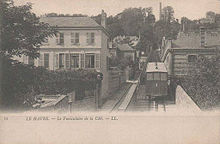Le Havre funicular
The Le Havre funicular ( French Funiculaire du Havre , colloquially: Funi ) is a funicular in Le Havre , a city in the Seine-Maritime department in northern France . It is operated by the transport company CTPO.
Technology and operation
The train connects Place Thiers in the city center with Rue Félix Faure. It is 343 meters long and overcomes a difference in altitude of 77 meters. The journey time is around three minutes. The standard-gauge line is single-track and has a turnout in the middle . In the upper part of the route, a short tunnel passes under Rue Georges Lafaurie. The cabins offer 20 seats and 40 standing places, and up to six bicycles or strollers can be taken. Wheelchair users are not allowed. At both stations you can change to several bus lines. The funicular runs every six to ten minutes Monday to Saturday between 7:30 a.m. and 9:00 p.m. and on Sundays and public holidays between 7:30 a.m. and 7:30 p.m. operations will be suspended on May 1st.
history
The city of Le Havre is characterized by the Côte , a plateau that is more than 80 meters above the city center and is traditionally used as a residential area. The steep slope and population growth created a demand for an efficient means of transport in the second half of the 19th century. In 1879 an application was made to the city administration to build a kind of tram elevator, but the strange looking project did not materialize for financial reasons. In 1886, a Parisian engineer named Lévêque presented a more serious project that involved building a funicular. The city granted a concession and Lévêque founded the company Chemin de Fer de la Côte , of which he was the main shareholder.
On April 23, 1889, the authorities determined the public benefit (déclaration d'utilité publique), after which the construction work could begin. The opening took place on August 17, 1890. Two cars with 48 seats each were available. It was driven by a steam engine . In view of its continued success, the company decided to switch to electrical operation in 1911. In 1944 the railway suffered great damage due to Allied bombardments. On July 25, 1945, the company became the property of the city. Due to extensive modernization work, operations were suspended between 1969 and 1972. The railway received new vehicles with rubber-tyred wheels.
literature
- Jacques Chapuis: Les tramways du Havre . In: Chemins de fer régionaux et urbains . No. 105. FACS et UNECTO, 1970, ISSN 1141-7447 .
- Hervé Bertin: Petits Trains et Tramways haut-normands . Cénomane / La Vie du Rail, Le Mans 1994, ISBN 2-905596-48-1 .
Web links
- Information from the public transport company on the funicular railway (French)
- Le Havre funicular. In: Structurae
Individual evidence
- ^ Chapuis: Les tramways du Havre. P. 18.
- ↑ a b c Bertin: Petits Trains et Tramways haut-normands. P. 206.
- ^ Chapuis: Les tramways du Havre. P. 22.
- ^ Chapuis: Les tramways du Havre. P. 19.
Coordinates: 49 ° 29 ′ 56 ″ N , 0 ° 6 ′ 40 ″ E

